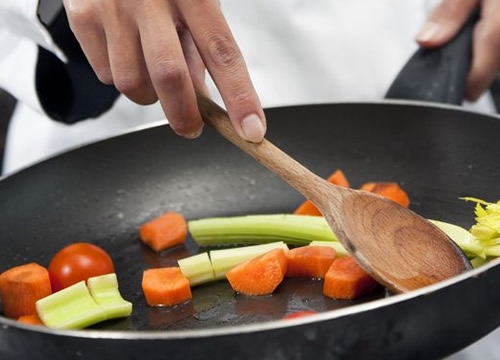How do you sweat vegetables?

Sweating is supposed to be something we do when we play sports. What in the world does it have to do with cooking?
Actually, there is somewhat of a parallel. When a person begins to exert themselves and their body temperature begins to go up, we sweat. Sweating is our body’s defense to overheating. Likewise, when we put some diced vegetables into a pan with a little oil and begin to cook them, moisture rises to the cut surfaces, making the vegetables look like they are sweating.
A sweat is similar to a sauté in that the goal is to cook small, uniform pieces of food in an open pan in a small amount of fat. The difference between the two techniques lies in the temperature. A sauté should be done over medium-high to high heat, and the goal is to cook quickly while browning the food. While a sauté can produce a finished meal, a sweat is almost always a preliminary step in a longer cooking method.
Why? Because in a sweat, you don’t want the food to brown, and we all know that that golden brown color of the Maillard reactions mean great flavor.
So, what is the point of sweating then, if it’s only a preliminary step? Is it really necessary at all? In my opinion, the answer is “Yes.”
In cooking, we take the time to sweat aromatics—onions, carrots, celery, garlic, shallots, etc—before adding other ingredients in order to start building flavors. Most aromatics are pretty crunchy when they are raw. This translates into strong cell walls.
Sweating helps to draw out moisture from the aromatics and weaken and soften the cell walls. Once the aromatics are translucent, which is easiest to see in the onions, you can add more ingredients and continue with the recipe knowing that you’ve given the aromatics a head start in cooking and drawing out flavors.
Steps to Sweating Vegetables:
- Dice or chop onions, carrots and celery to roughly 1/4" pieces. The more uniform your pieces, the more evenly they will cook, so dicing is preferable to chopping.
- Mince garlic and/or shallot.
- Heat a pan over medium low heat until hot.
- Add a small amount of oil (no more than 2 tablespoons) to the pan and swirl to coat.
- Let the oil heat for a few seconds.
- Add the diced vegetables to the pan along with a healthy pinch of salt; the salt will help to draw out water from the vegetables.
- Adjust the heat so you can only hear a gentle sizzle. You should not hear loud sizzling or popping, if you do, turn down the heat to maintain the gentle sizzle.
- Stir the food frequently—remember, you don’t want to brown the food, so keep it moving.
- Add the minced garlic and/or shallot (if using), and continue to cook and stir.
- Once the vegetables are softened and translucent, about five to ten minutes, you are finished with the sweat and can then continue with the recipe.
- https://reluctantgourmet.com/

Barbara Williams
"Dan's Right Hand"
Creative DVO Employee since 2007

